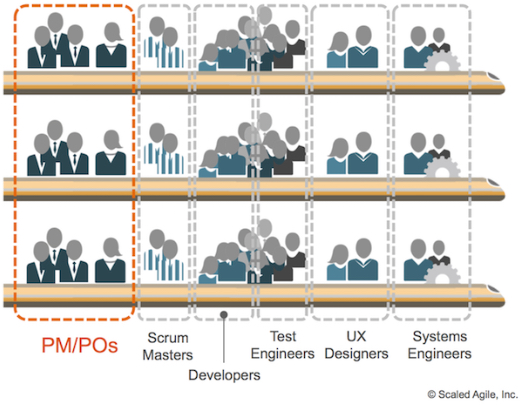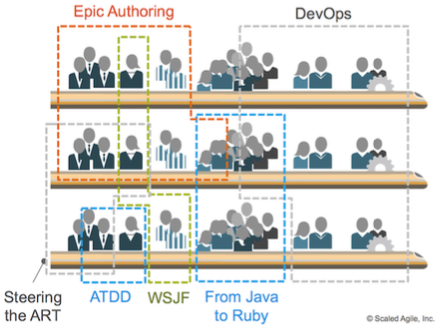
This blog is part of a series on Lean portfolio management for the enterprise. If you haven’t already, we recommend reading:
- Part 1: What is Lean Portfolio Management?
- Part 2: Lean Portfolio Management: Lean Budgets and Investment Funding
If you’ve read the first two parts in this series, you understand that traditional approaches to portfolio management may no longer be able to keep up with the blistering pace of the global economy or of digital disruption. Traditional approaches, which are typically more lengthy and linear in fashion, may inhibit the flow of innovation and value through your organization, and as such, making it challenging to undergo a Lean-Agile transformation without transforming your organization’s approach to portfolio management. In the first two installments of this series, we talked about the key elements of Lean Portfolio Management (LPM) and how funding practices must adapt to better support LPM initiatives. Now, let’s delve further into developing an agile approach for Lean portfolio management operations.
Adopting Agile portfolio operations practices is an equally important component to the success of your Lean-Agile transformation.
Traditionally, in an effort to maintain alignment and consistency across the portfolio, organizations have dedicated a centralized Program Management Office (PMO) to planning, program management, and solution definition. The problem with this structure begins and ends with the way projects are funded, as we learned in our last post. To summarize:
- Organizing temporary teams around projects (moving people to the work) results in lower-performing, inefficient working groups
- Project-based funding requires detailed plans based on inaccurate projections, which takes time and people away from actually delivering value
- Planning on an annual basis creates a state of perpetual overload, which decreases productivity, morale, and throughput
- Progress is measured based on compliance to plan, instead of actual business outcomes or customer satisfaction
A project-based funding structure creates a slower, more complicated budgeting process that requires estimates, plans, and details far before they are able to be accurate. By the time a plan is approved, and the team is able to begin work, it likely already has to be updated to account for new information and changing requirements. But accounting for new information might require additional paperwork—so teams are actually somewhat incentivized to not incorporate new learnings into the project for fear that may result in time and/or budget changes that will further push their project(s) off track.
By contrast, the Agile approach to Lean Portfolio Management operations encourages a decentralization of program management, shifting the power of planning and execution with empowered, self-sufficient Agile Release Trains (ARTs) and Solution Trains.
But how do you maintain alignment with broader organizational goals when ARTs are working relatively independently? Through centralizing key elements of portfolio operations by utilizing new, different operational functions such as an Agile PMO, and Lean-Agile Centers of Excellence (LACE).
Didn’t we just say that a centralized PMO undermined LPM? Yes—but an Agile PMO and a Lean-Agile Center of Excellence performs an entirely different role than a traditional PMO. Rather than ‘owning’ the day-to-day decision-making power around program strategy, funding, and execution, the role of an Agile PMO (APMO) or a LACE group is to:
- Coordinate value streams
- Support program execution
- Drive operational excellence (source)
Before diving deeper into each of these responsibilities, let’s take a closer look at what a LACE group really is.
Lean-Agile Center of Excellence (LACE)
A Lean-Agile Center of Excellence (LACE in SAFe terms) is another area where APMO involvement can help drive operational excellence. A Lean-Agile Center of Excellence describes a small group of people dedicated to promoting the Lean-Agile way of working. Typically, the presence of a healthy, high-performing LACE is the differentiator between organizations who achieve better business outcomes through Lean-Agile implementations, versus those who simply practice Agile in name.
The responsibilities of the LACE typically includes everything from communicating the need and urgency for change, facilitating Lean-Agile training, reporting on the progress of Lean-Agile initiatives, and assessing progress on each of the Five Competencies of the Lean Enterprise.
The LACE may be part of the Agile PMO, or it may exist as a standalone unit. In either case, it can serve as a continuous source of energy to power the enterprise through necessary changes. Often, as the organization matures in its Lean-Agile development, the LACE evolves into a longer-term center for continuous improvement.
Now, let’s break down the responsibilities of an APMO or LACE group, starting with coordinating value streams.
Coordinate Value Streams
The true value of offering a portfolio of solutions is the ability to leverage integrated capabilities to respond to expanding end-user patterns and needs. As such, while many value streams may operate independently within your portfolio, it’s important to dedicate effort to building cooperation and collaboration between different parts of the business and to be able to provide those portfolio-level benefits and alignment that help the business deliver better business outcomes.
For many organizations, this is the ultimate goal—to operate with a sort of Swiss army knife-type of versatility, with the agility to anticipate and respond to user needs with the exact tools for the job. The APMO (and other Lean-Agile leaders/groups within the organization) help coordinate efforts across the value stream to manage dependencies and exploit opportunities within the portfolio.
An article by Scaled Agile, Inc, creators of the Scaled Agile Framework (SAFe®) explains this responsibility (and opportunity) this way:
“…thoughtful coordination can create a differentiated and unmatchable Solution offering. To this end, Lean-Agile Leaders understand the challenge and opportunity their value streams provide. They make them as independent as possible, while simultaneously interconnecting and coordinating them with the enterprise’s larger purpose.” (source)
Support Program Execution
While it can be tempting to completely forego the function of a PMO, it’s important to understand that the Agile approach to Lean Portfolio Management operations very much includes a type of centralized program management capability. Distributing all responsibilities to ARTs and Solution Trains will result in an organization that will inevitably face the same tensions around funding and resource allocation as a traditional bureaucracy.
Although it requires a drastic culture shift within the PMO, many organizations are best served redesigning their traditional PMO to become an Agile PMO. Ultimately, the people within your PMO have the skills, knowledge, and relationships with managers, executives, and other key stakeholders that can be extremely useful in not only managing change, but in getting things done. To disown them would not only be a monumental waste of resources and time, but it would also be greatly detrimental to the culture.
Embracing the PMO as agents of change and encouraging them to adopt Lean-Agile practices (and the role of an APMO) is the most productive and beneficial way to approach this transition.
Usually, as it matures, the APMO can provide additional support to program execution. They can:
- Sponsor and communicate the change vision
- Participate in the rollout (some members may even deliver training)
- Lead the move to objective milestones and Lean-Agile budgeting
- Foster more Agile contracts and leaner Supplier and Customer partnerships (source)
To maximize the impact and effectiveness of the APMO, many organizations include Release Train Engineers and Solution Train Engineers in their APMO, so that they can share insights into best practices, common program measures, and standard reporting.
Drive Operational Excellence
The APMO plays a leadership role in helping the organization improve operational efficiency (and therefore achieve its business goals). There are two primary ways that the APMO can drive operational excellence in LPM: sponsoring Communities of Practice (CoP) and a Lean-Agile Center of Excellence.
Communities of Practice (CoPs)
Communities of Practice (CoPs) are organized groups of people who typically share a common, specific technical or business domain. They meet regularly to share information, improve their skills, and actively work on advancing the general knowledge of the domain within the organization.

An example of a CoP is a group of Product Managers from across your portfolio who may not typically work together on an ART, but who would benefit from sharing best practices and insights. CoPs not only help drive operational excellence, they also provide employees with rich opportunities for mentorship and professional development that they might not otherwise receive.
An Agile PMO can sponsor and support role-based CoPs for Release Train Engineers and Scrum Masters, to provide a forum for sharing effective Agile program execution practices. CoPs can also be topic-based, but this typically happens further along in LPM maturity.

Lean More
We hope that this piece has given you a comprehensive overview of how business operations must evolve to support the needs of your LPM strategy. In the last installment of this series, we’ll discuss Lean governance in LPM and how it influences spending, future expense forecasts and milestones, and governance of the development effort.
Be sure to download the full whitepaper, Lean Portfolio Management for the Enterprise, for more information and greater detail on what we have discussed here.





